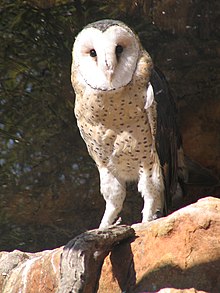Tyto
|
Tyto Temporal range: Late Miocene–Recent |
|
|---|---|
 |
|
|
African grass owl, Tyto capensis The "grass owls" are two rather long-legged species of Tyto. |
|
| Scientific classification | |
| Kingdom: | Animalia |
| Phylum: | Chordata |
| Class: | Aves |
| Order: | Strigiformes |
| Family: | Tytonidae |
| Subfamily: | Tytoninae |
| Genus: |
Tyto Billberg, 1828 |
| Species | |
|
About 20, see text |
|
| Synonyms | |
|
Lechusa Miller, 1956 |
|
About 20, see text
Lechusa Miller, 1956
Strix sensu auct. non Linnaeus, 1758 – preoccupied
The genus Tyto includes all barn owls (family Tytonidae) except for the bay owls (subfamily Phodilinae, genus Phodilus) – that is, the true barn owls, the grass owls and the masked owls collectively making up the subfamily Tytoninae. They are darker on the back than the front, usually an orange-brown colour, the front being a paler version of the back or mottled, although there is considerable variation even amongst species. Tyto owls have a divided, heart-shaped facial disc, and lack the ear-like tufts of feathers found in many other owls. Tyto owls tend to be larger than Bay-owls. The name tyto (τυτώ) is onomatopeic Greek for owl.
Throughout their evolutionary history, Tyto owls have shown a better capability to colonize islands than other owls. Several such island forms have become extinct, some long ago, but some in comparatively recent times. A number of insular barn-owls from the Mediterranean and the Caribbean were very large or truly gigantic species.
Living and recently extinct species – and some notable subspecies – of barn owls are:
Known from ancient fossils
Usually known from subfossil remains.
Melanesia:
A number of owl fossils were at one time assigned to the present genus, but are nowadays placed elsewhere. While there are clear differences in osteology between true owls and barn-owls, there has been parallel evolution to some degree and thus isolated fossil bones cannot necessarily be assigned to either family without thorough study. Notably, the genus Strix has been misapplied by many early scientists as a "wastebin taxon" for many owls including Tyto.
...
Wikipedia
